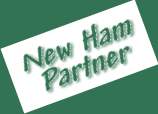
What's all this Digital communications stuff anyway? What equipment will I need for digital communications modes such as packet? Will I need additional cables and antennas, or radios.?
If you have flipped through the 2 meter and 70 cm bands, you may have heard short burst of what sound like noise or modem tones. That's the sound of digital communications over the radio.
Digital communications allow our computers to talk to each other in a binary language. The messages are broken up into short binary blocks or "packets" . A small amount of overhead information (such as your call sign) is added to the packets, then it is transmitted over the air as audio tones
Why use digital communications at all. Isn't Voice good enough? For many uses these days the answer must be "NO". Computers in the shack are now as much a part of the ham shack as the radio, coax or power supply. We use them for everything from plotting a satellite's location to computerized logging of QSO's. Sooner or later we want to transfer the file to someone else and when that time comes its easier to transfer that file by some form of digital communication. It’s much better than using "sneaker net" where you put the file on disk, then put on your sneakers and run it over to another machine. To quote an instructor of mine: "I had the choice of whether or not to get involved with computers, My children will not, nor will yours" Even the conservative ARRL is on the Internet.
Packet radio is keeping the ham spirit alive by giving us true WIRELESS digital communications.
Chances are that you already have the computer and a radio (all the equipment needed to get started in Packet radio). The only additional equipment that is needed is the device that breaks up the data and converts this into audio. This device is known as TNC or Terminal Node Controller. Prices range from about $100.00 for a simple packet mode only TNC to $500.00 plus for a multimode TNC. Other than that the only additional software you might need is a terminal communications package such as ProComm or Crosstalk for DOS/Windows or Microphone or White Knight for the Macintosh
One important thing to remember about digital communications, as the bit rate goes up, so does the occupied bandwidth. For this reason packet on HF is limited to 300 BPS. Packet on VHF and UHF where we have a larger spectrum of bandwidth can be 1200 BPS to 9600 BPS.
Most TNC's have the ability to run both 300 and 1200 BPS but depending on the manufacturer, running 300 BPS HF Packet may not be recommended. TNC's that are meant specifically to run HF Packet will have a tuning indicator on the front of the Chassis to tune in the signal for optimum transmission.
Because of the large bandwidth used at 9600 BPS packet, the radio must be have a larger receive and transmit IF Band pass for 9600 BPS. If you will look in any amateur radio magazine now you will probably see ads for radios listed as "9600 BPS Ready" meaning that the these radios will work at 9600 BPS packet. Other wise the radio must be modified for the larger bandwidth required for 9600.
One important thing to remember is that in Packet radio, there are two sides of the TNC. The Radio side (the part connected to the radio) and the Terminal side (the part connected to the computer). The radio side will be limited to 300bps, 1200bps or 9600bps depending on the TNC you purchase. The terminal side will limited to the highest speed your communications software can handle (300 to 19.2 kbps). Do not assume that because the radio side is running at 1200bps you have to run 1200bps on the terminal side.
Interface cables between the radio and TNC usually have to be custom Manufactured by the user. This is because of the wide variety of Mike and Speaker connections found on transceivers. Some manufactures such as MFJ make interface cables that you can buy to interface there TNC to the more popular radios. The literature that comes with the TNC will usually have a collection of drawings that shows how to interconnect the TNC to a wide variety of radios. For this reason if you are purchasing a previously owned TNC, be sure you are getting the users manual as well as the hardware.
Packet radio used to be a real insiders game. Tweaking the software parameters on the TNC was something you had to know how to do or you needed to be in contact with a BBS operator who would talk you through the set up. Now that the packet standards have firmed up and the manufactures are making the TNC's with a very complete standard set of commands the Packet Radio is pretty much a "Plug and Play" affair (other than a calibration setup to set the Transmit and Receive levels).
If you even remotely involved with computers, enjoy the world of WIRELESS digital communications.
Gerry WD4BIS
![]()
Copyright 2005 Gerald Crenshaw WD4BIS. All rights are reserved.
Permission in advance is granted to those who use this for non-profit Amateur Radio club newsletters as long as it is used unmodified including this copyright notice and that notice is given to the author via email ([email protected]). In addition, please forward a copy of any newsletter this appears in to: Gerry Crenshaw WD4BIS, c/o GARC, 1027B W. Austin St, Garland, TX, 75040
Web site maintained by Janet Gobeille Crenshaw (WB9ZPH)